|
|
Bend Or

|
|
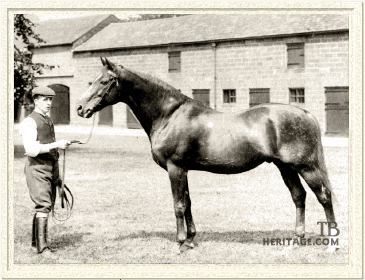 |
|
|
Courage, class, beauty, kindness...that's how Bend Or was described by those who knew him and watched his career on the turf and in the stud. Born and bred at the Eaton Stud near Chester, England -- where Touchstone was born and briefly stood at stud --the golden chestnut had a suitably golden name and a sterling racing career, followed by a wealth of progeny who spread his influence throughout the world. He was owned all his life by Hugh Lupus Grosvenor, the first Duke of Westminster, the richest man in England in the latter half of the 19th century.
Not all was golden in his life, however. He suffered from sore shins throughout his three and four year old years, and, from his pictures when he was at stud, it's clear his fetlocks took a pounding, too. Further, after his thrilling Epsom Derby win, his parentage was called into question by the owners of the horse he narrowly defeated, Robert the Devil, prompted by testimony of a discharged groom from Eaton, named Arnull. Arnull had alleged, or started rumors, or been paid to start rumors, that Bend Or and another yearling by Doncaster, later named Tadcaster, had been erroneously switched sometime after the two chestnut colts, and two fillies, were sent as yearlings, first to the paddocks of Mr. Barrow at Newmarket, and then to Robert Peck's training yard at Russley. The claim was that Bend Or was not out of the Thormanby daughter Rouge Rose, but out of Clemence, a mare by Newminster. This provoked a Stewards' Inquiry at Epsom after the race, settled in July by reaffirming Bend Or, was in fact, the son of Rouge Rose. It didn't help that the Eaton stud records were poor to non-existant, and that foaling records were not kept, which required testimony three years after the fact by various superintendents at Eaton, and at Russley, and that it was all based on memory and opinion.
Ostensibly settled, the controversy simmered for years, despite support of the Rouge Rose breeding by various experts, such as E. Somerville Tattersall of the famous sales company; Michael Gurry, who was the supervisor of the yearlings at Russley, and others. It resurfaced after the turn of the century, with letters to the Bloodstock Breeders Review of 1914, and is occasionally raised in essays and books about thoroughbred breeding. Over one hundred and twenty years after the inquiry, it's probably safe to say that whichever mare foaled Bend Or is not the burning issue now that it was then.
|
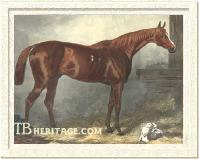
Doncaster
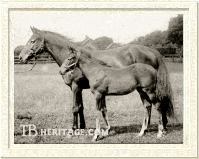
Rouge Rose. Photo courtesy Jenny Rutlidge.
| |
Bend Or's sire, about whom there was no dispute, was the big flashy chestnut Derby winner Doncaster, purchased by the Duke with the intention of re-establishing Eaton as a premier racehorse breeding facility, as it had been in the days of his grandfather, Robert Grosvenor, Marquess of Westminster and 2nd Earl Grosvenor -- who bred the great sire Touchstone -- and great-grandfather, Sir Richard Grosvenor, later 1st Earl Grosvenor, who had a large racing stable and breeding establishment, and had a significant influence on late 18th century thoroughbred breeding.
Rouge Rose, Bend Or's probable dam, was one of a relatively small band of broodmares at Eaton -- only sixteen or so in 1880 --about whom, Arnull's successor, Richard Chapman, said "There was not a 'worst' among them. Any mare that showed defects was at once weeded out and replaced by a better one. This strictness resulted in other studs securing many a bargain, but the Duke never expressed regret for having parted with a mare that afterwards turned out well."
Rouge Rose was by Derby and Ascot Gold Cup winner Thormanby, who had been leading sire in England in 1869. Her dam was Ellen Horne, a very good broodmare who was granddam of English Triple Crown winner Lord Lyon, of the dual-classic winning filly Achievement, and of Illuminata, who produced Ladas and Chelandry.
|
Rouge Rose had produced the filly Red Rag (1870), by Lord Lyon, who was dam of the Manchester Cup winner Red Ensign, and her sister, Red Flag (1871), grandam of two Austrian Derby winners. After Bend Or, she produced his sister, Rose of Lancaster (1878), second dam of Robert le Diable (1899), and then Rose of York (1880), by Speculum who was the dam of the great French race mare Roxelane (1894); Roxelane became dam of the grey Roi Herode (1904), whose son, The Tetrarch had such an influence on early 20th century breeding in England.
Bend Or was a big, growthy colt, like his sire and grandsire, Stockwell, but unlike them, his parts came together well enough for him to run well at age two. He had a golden chestnut coat, and a silvery mane and tail, unlike the red coat of the lop-eared Tadcaster, the horse he was averred to be after the Derby. He had a strong shoulder and fairly high withers, and powerful quarters that helped propel him to many of his close wins. "Bend Or," E. Somerville Tattersall later remarked, "was extraordinarily handsome and powerful."
His face featured a blotchy blaze that gave his unremarkable head a bit of character. He had white flecks in his coat, and black spots on his neck, shoulder, and quarters, like his dam's sire Thormanby, including one distinctive spot on his fore fetlock. Today, those spots are referred to as "Bend Or spots," and have been seen in many of his progeny, up to the present. Their appearance in Bend Or's pedigree can be traced at least as far back as Pantaloon (1824); Bend Or's half-sister's great-grandson, The Tetrarch, displayed them in abundance in his grey coat. Alternatively, these markings could trace to the white and dark-spotted chestnut stallion Comus, who appears twice in the fifth generation of Doncaster's dam, Marigold.
Bend Or was blessed with a wonderful temperament, apparently shared by all of Rouge Rose's offspring, which, according to Peck's yearling superintendent, Gurry, was not a characteristic of the sons and daughters of Clemence, which Gurry called "bad-tempered brutes." The Eaton stud groom Richard Chapman said of Bend Or after his retirement "He was the sweetest-tempered horse in the world. A child could do anything with him. During the season he walked, on an average, a hundred miles a week...he was led by his attendant, Ben Jenner, who had looked after him when he was in training and who came with him to Eaton from Russley....Bend Or was as docile as a lamb, but he had the courage of a lion. I was always very fond of him." Among the stories about Bend Or passed down to Ben Jenner's great-great grandaughter, Jenny Rutlidge, is that he was very attached to a cat, who travelled with the horse to the races. In the Jenner family history Bend Or is known as an "affectionate horse" that "had a great character."
Bend Or on the Turf
When a long yearling, Bend Or was sent to trainer Robert Peck at Russley, who had trained his sire, Doncaster. Although a big colt, he matured much faster than either his sire or grandsire, Stockwell, and proved to be a high class two year old with an unbeaten record his first season. He debuted in July in the four-furlong Chesterfield Stakes for juveniles, which he won by four lengths. He went on to win the six furlong Richmond Stakes at Goodwood, carrying 128 pounds, and followed that with the Prince of Wales' Stakes at York, which he won by half a length. In October he won the five furlong, 140 yard Triennial Produce Stakes, and the next day ran in and won the Rous Memorial Stakes over five furlongs by two lengths.
He had five races as a three year old, plagued by shin trouble for much of the season. His first start that year was in Derby, considered by all who saw it as one of the most exciting to that time. In it, about four lengths from the finish, Bend Or was behind Robert the Devil, who appeared to have the race won. Bend Or's jockey, the famous Fred Archer, who had an injured arm in a brace, raised his whip, forgetting his injury, and, weighted by the iron, the arm fell uselessly and Archer sat down to ride one-handed. Stride by stride, Bend Or gained on Robert the Devil, whose jockey seemed frozen by his approach and only reached for his whip when Bend Or was beside him. It was too late; Bend Or won by head, and the crowd went wild, while Bend Or walked back to the barn crippled by the pain in his legs.
His next race was two weeks later, the St. James' Palace Stakes, which he won by a head in a hard-fought battle with Fernandez. After that, he was rested until September, when he ran in the St. Leger in a heavy rainstorm; in that race he ran fifth, Robert the Devil finishing first. He was beaten again, this time by a head, by Robert the Devil in the Second Great Foal Stakes at Newmarket over 1-1/4 mile, 73 yards, each carrying 131 pounds. His third defeat of the year, in his last race of the season, was again by Robert the Devil, by ten lengths, in the Champion Stakes in October.
At age four he started as a 100 to 8 shot in a field of twenty-three in the City and Suburban Handicap at Epsom, which he won by a 1-1/2 lengths over the American 3 year old, Foxhall, who had won three races, including the Cesarewitch in England and the Grand Prix de Paris in France. In his next race, the one and one-half mile Epsom Gold Cup Bend Or beat his nemesis, Robert the Devil by a head. He followed that win by beating the American racehorse, Iroquois, who had won the Derby but ran third in this race, the Champion Stakes at Newmarket. His last race was the Cambridgeshire, where he carried the heaviest weight by 8 pounds and was troubled by a sore leg. He finished fifth to Foxhall, Lucy Glitters and Tristan.
|
|
Bend Or's Race Record
|
| Year |
Age |
Starts |
1st |
2nd |
3rd |
Unplaced |
| 1879 |
2 |
5 |
5 |
0 |
0 |
0 |
| 1880 |
3 |
5 |
2 |
2 |
0 |
1 |
| 1881 |
4 |
4 |
3 |
0 |
0 |
1 |
| Total |
-- |
14 |
10 |
2 |
0 |
2 |
| | Bend Or was retired to stud at the end of his four year old year. His frequent jockey, Fred Archer -- who rode Derby winners Silvio, Iroquois, Melton, Ormonde, and many other greats -- said he was one of the greatest horses he ever rode, probably the greatest.
|
Bend Or in the Stud
Bend Or was retained by the Duke, and went to stud at Eaton. His book was always limited, at most, to forty mares, and often less. At the end of each season, he was, according to Eaton stud groom Chapman, "let down in condition by stopping his corn," and he was turned out in pasture.
Bend Or got some very good sons and some productive daughters in the stud, and he is still representative of the most influential sire line in tail-male descent today. Despite the success of his descendants in the breeding shed, worldwide, he sired surprisingly few top class racehorses, but of them, one, ORMONDE, was one of the best, ever. Still, it is not from Ormonde, but from Bend Or's only other English classic winner, BONA VISTA, who won the Two Thousand Guineas and who ended his stud career in Hungary, that the line descends in strength to this day, due to Bona Vista's great-grandson, Phalaris.
One of the all-time famous breeding patterns noted by various turf observers over the years, is the Bend Or - Macaroni "nick," or bloodline affinity, where it was claimed Bend Or was best and most successfully crossed on daughters of the 15 hand-3/4 inch tall dual classic winner Macaroni. Macaroni has been highlighted in red below; readers can make their own judgement.
|
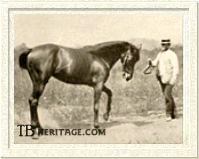
Ormonde, English Triple Crown Champion | |
ORMONDE (1883), out of the Macaroni mare Lily Agnes, was Bend Or's best racing son, and the best racehorse of the 19th century, and perhaps of all time, winner of the English Triple Crown and the Grand Prix de Paris and unbeaten in his sixteen races over three years. Despite this, the Duke of Westminster sold him out of England to Argentina after two seasons at stud in England, where he got only seven foals total, five of them winners. Of the winners, Orme (1889), out of the Galopin mare, Angelica, was a top class racehorse who won fourteen of his eighteen races to age four.
|
In the stud Orme got Flying Fox, like his grandsire a winner of the English Triple Crown; Derby winner Orby, and One Thousand Guineas winner Witch Elm. Through Flying Fox and his French-bred son, Ajax, the sire line continued to Teddy and his famous sons. Despite all its brilliance, the Bend Or sire line from ORMONDE is no longer of much influence in the direct sire line.
In Argentina it became clear ORMONDE was almost sterile; despite this, an English consortium was put together to purchase him back to England, although the syndicate later fell apart. In the meantime, American coal-heir William Macdonough purchased the horse for an unheard-of $150,000, and brought him to California, where he was presented with the best mares available in the west. In all, between 1894 and 1905 he sired 17 foals, and of these five were stakes winners, including Ormondale, his most successful California son. With increasing difficulties in breathing, ORMONDE was destroyed at the age of 21 in California; he was later exhumed and his bones sent back to England.
|
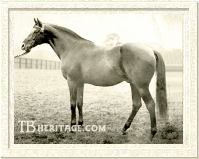
Kendal
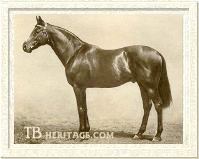
Martagon
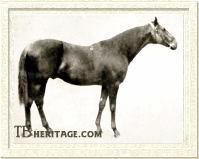
Bona Vista
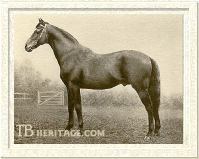
Orvieto
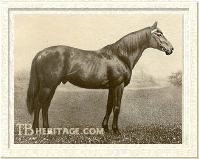
Laveno
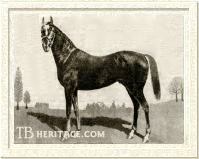
Orbit | |
KENDAL, like Ormonde, was from Bend Or's first crop of 1883, out of Windmere, a Macaroni daughter. He was a good two year old, winner of six races, including the July Stakes, but he injured himself during the running of the Rous Memorial Stakes, which he won, and never ran again. He was a popular sire, and rose to the top of the sire's list in England in 1897, largely due to his son Galtee More (later sire of German sire Fervor), who won the English Triple Crown that year. He also sired Galtee More's brother, Blairfinde, who won the Irish Derby, and the useless racehorse but fair sire, Tredennis.
KENDAL was sold to Argentinian Raul Chevalier as a replacement for Gay Hermit at Haras Ojo de Agua. He became an influential sire in South America, where he got such classic winners in Argentina as Barsac, later a good sire in Chile; Floreal, winner of the Gran Premio Nacional and other top races; Casiopea, winner of the Jockey Club stakes, and many more. In Chile he got Pinche, who won several top races and Perfecta, winner of the Chilean Oaks. He also got a number of good daughters seen in Chilean and Argentinean pedigrees.
MARTAGON (1887), out of Macaroni daughter Tiger Lily, was a big sturdy horse, who won the Ascot Gold Vase and the Goodwood Cup in nineteen starts, and was later a prolific sire whose offspring tended to be stayers; he also got some good jumpers. He got three classic winners, Wool Winder, who won the St. Leger and later was sent to Austria for stud duty, where he was fairly successful. Martagon's daughters, Musa and Snow Marten, won the Epsom Oaks. Other offspring included son Mazagan, who won several good races, including the Lowther Stakes, the Goodwood Cup and the Jockey Club Cup, and another son, Mintagon, who won the Cesearwitch Stakes. Another Martagon son, Buckwheat, got Waffles, who produced two English classic winners. Daughter Marliacea (1902) ran for three years, and became third dam of Blenheim.
BONA VISTA (1889), out of Vista, by Macaroni, won Woodcote Stakes at age two, and the 2,000 Guineas Stakes at age three, and then became a successful sire. He got Cyllene, who won the Jockey Club Stakes, and the Ascot Gold Cup and was later two-time leading sire in England, with four Derby-winning sons, and then was sent to Argentina, where he became a leading sire. It is through Cyllene's son, Polymelus, who won the Cambridgeshire and other races and became a top sire, and Polymelus' son, Phalaris, that this sire line proliferated into the present. Bona Vista also sired Vahren, dam of The Tetrarch. Bona Vista was later shipped off to Hungary, where he was leading sire five times.
Brothers ORVIETO (1888) and LAVENO (1892) were out of the Macaroni daughter Napoli. Orvieto was a good winner of such races as the Sussex Stakes, the Great Yorkshire Stakes, the Newmarket Derby and the Newmarket St. Leger, and later sired the good race horse Picton, who got Light Brigade, the latter a winner of the Ascot Triennial and the Great Yorkshire Stakes, among others, who was later a good sire in the U.S., primarily of broodmares.
Laveno won the Jockey Club Stakes and the Champion Stakes, his only wins in eleven starts, and later became a prolific sire; his daughter Padula was dam of the American racehorse and sire, Black Servant, whose top racing son, Blue Larkspur became a good broodmare sire in the U.S.
ORBIT (1895) was out of Cambuscan daughter Fair Alice. He was a good two year old, and at age three won the Craven Stakes and the Eclipse Stakes, but his best in the classics was a third in the 2,000 Guineas. He was purchased at age 4 by Argentinian Felix Rivas specifically to run in the Gran Premio Internacional, but arrived in Argentina in poor condition, and subsequently was sent to the stud there where he became so highly influential throughout South America that he was given the nickname "Stockwell Sudamericano" [South American Stockwell]. Among his most notable sons were Olascoaga, a top racehorse in Chile and later a leading sire there; and Old Man, whose offspring won 685 races in Argentina and dominated the classics there for some years.
|
RADIUM, from the Donovan mare Taia, was born in 1903, the year Bend Or died. He was considered Bend Or's most attractive son, and the one most like him in looks. He was a good race horse who won ten of his twenty-four starts, including the Goodwood Cup, the Doncaster Cup and the Jockey Club Cup. In the stud he got 2,000 Guineas winner Clarissimus and his brother Paragon II, winner of the City and Suburban Handicap; the filly Fairy Ray, who through daughter Marguerite was second dam of some top American racehorses--Petee-Wrack, Fighting Fox, Foxbrough and American Triple Crown winner Gallant Fox; and Night Raid, sire of the great Australian racehorse Phar Lap.
Bend Or had a number of other good sons. ORNUS (1891), from the Albert Victor mare Ashgrove, was sent to the U.S., where he sired the top race horse Oiseau and Olambala, a good stayer, who later sired dual American classic winner Pillory, Travers Stakes winner Hannibal and the U.S. champion two year old, Campfire. Son OSSORY (1885), a full brother to ORMONDE, and, like him, a roarer, won the Prince of Wales Stakes, the St. James Palace Stakes, the Criterion Stakes and the Great Yorkshire Stakes. ORION (1888), out of the great race mare Shotover, by Hermit, won three races at age two, including the Prince of Wales' Stakes, and at three won the Champion Stakes. Other Bend Or winning offspring include THE PRIZE (Champagne Stakes; 1890, Satchel - Galopin), IDLE BOY (Prix Daru; 1891, Vesper - Kingcraft), GUERNSEY (Craven Stakes; 1894, Jersey Lily - Beauclerc (out of Tiger Lily by Macaroni), GARB OR (Gimcrack Stakes; 1898, Bright Alice - MacHeath), LORD BOBS (Rous Memorial Stakes, July Cup, Dewhurst Stakes, later sire in Chile; 1898, Silver Sea - Hermit), Rouge Croix (Dewhurst Stakes; Dame Agneta - Cabin Boy).
Bend Or's Daughters
Bend Or did not produce a single classic-winning daughter, nor were any of his fillies exceptional race horses, although he did get a few multiple stakes winners. Generally speaking, some were fair winners of such juvenile races as the Eglinton Stakes, Zetland Stakes, Rous Memorial Stakes, and the like, but few trained on to win, or even place at age three. Probably his most consistent daughter was the 1890 filly TRESSURE, who ran in top company at age three, and managed a second in the Epsom Oaks and a third in the One Thousand Guineas, among other placings.
As it turned out, it didn't matter how his daughters did on the turf, because they made up for it in the stud, many producing at least one top racehorse, or failing that, becoming second or third dams of good runners and influential breeding stock, sending Bend Or's influence all over the world. Probably his two best daughters in the stud were ORNAMENT, the dam of the great race mare Sceptre and a number of other good racing horses, and FAIRY GOLD, who produced two winners in England before being sold to America, where she became the dam of two top sires and race horses, Fair Play and Friar Rock.
FAIRY GOLD (1896), out of the Galliard Daughter, Dame Masham, was a pretty good filly, who beat the colt, Desmond, in the important juvenile race at Epsom, the Woodcote Stakes; at age three she ran six times and won once, the Welter Handicap at Lingfield Park. In England she produced the filly St. Lucre (1901) and the colt, Golden Measure (1902), who won the Ascot Gold Vase, the Ebor Handicap and some other races. St. Lucre was the dam of the incredibly prolific and exceptional broodmare, Zariba (1919), who was a very good race mare in France, later purchased to the stud of Marcel Boussac. For Boussac she got some top youngsters: Corrida, her daughter, won the Arc de Triomphe twice, and produced a French Derby winner and sire Coaraze. Zariba's other top youngsers included Abjer (1933), Goyescas (1928) and Goya II , the latter champion older horse in France twice, and then champion sire.
Shipped to the U.S. in 1903, Fairy Gold became part of August Belmont's broodmare band. Bred to Belmont's principal stallion, Hastings, she produced Fair Play (1905), who became a good three year old, often beating track records, able to stay, and sound; his victories included the Lawrence Realization Handicap, the Brooklyn Derby, the Jerome Handicap and a number of other races. In the stud, he led the sires list three times, his best, of course, being Man o' War, and others including Mad Hatter, Chance Play, Chance Shot, Display, Ladkin. In 1913 Fairy Gold produced the chestnut-coated, black-spotted Friar Rock to Rock Sand, who was champion three year old in the U.S., and later got Friar's Carse, dam of War Relic, War Kilt and Speed Boat.
|
| 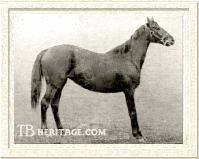
Fairy Gold | | 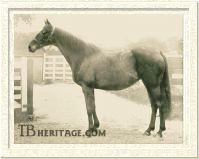
Ornament |
|
ORNAMENT (1887), out of Lily Agnes, by Macaroni. Full sister to the aformentioned Ormonde, ran and lost once, and was sent immediately to the Eaton stud. She produced the versatile Star Ruby (1892), who ended up as a stallion in California, where he got several American classic winners and Rubio, who returned to England to win the Grand National at Aintree. She got some other good winners, and a daughter, Splendid, who bred on, but her best was the great race mare Sceptre (1899), the only horse to win four English classic races. |
Below is a list of some of Bend Or's other good daughters in the breeding shed, one of the more remarkable features being their geographic spread and influence.
POLYDOR, dam of Polymnie (1895) by Fra Diavolo, winner of the French One Thousand Guineas.
QUETTA (1885), out of Rosicrucian daughter Douranee, was dam of two Pepper and Salt sons, Cayenne, winner of Criterion Stakes, and Grey Leg (1891); the good race filly Helm, winner of the Coronation Staks and the Yorkshire Oaks; Frontier, winner of the Dewhurst Stakes and Edward VII Stakes.
SALTIRE (1885), out of Cathedral daughter Stillwater, dam of Cesarwitch winner Scintillant.
GULBEYAZ (1886), was out of Sultana by Oxford. She won four minor races as a juvenile, including the Dyke Plate, Exning Plate and Biennial Stakes, and at age 3 placed a couple of times in minor events. She was second dam of the Dark Ronald sons Ambassador and Brown Prince, the latter winner of the Jockey Club Cup and the Cambridgeshire Stakes and later a fair, if short-lived sire. She was also ancestress of Oaks Stakes winner Rose of England and her son British Empire and of the good handicap horse, Winalot, who became a fair sire.
SUNDEW (1886), also out of Stillwater, dam of Sirdar, winner of classic races in Russia and Poland, including the 3200 meter President of the Republic race in Poland.
RYDAL (1886), out of Macaroni daughter Windemere, was dam of the good filly Lowood who won Coronation Stakes and Park Hill Stakes; of Rydal Fell, third dam of the great 1928 filly Pearl Cap, winner of multiple races in France, including the Prix de l'Arc de Triomphe; of Rydal Mount, second dam of St. Leger Stakes winner Troutbeck, and of Rydal Head, who won the Prince of Wales Stakes.
PLUIE D'OR (1887), out of a Marfiori daughter, was dam of Regenwolke, winner of the German 2,000 Guineas and of the Grosser Hansa Preis.
ORIOLE (1887) out of Cambuscan daughter Fenella, produced Ogden, a top two year old in the U.S., who was also good at age 5, and later was sire of Sir Martin, champion U.S. two year old and of The Finn, who won the Withers and Belmont Stakes, among other races and later sired Kentucky Derby winner Zev.
ROSEDALE, who was stakes-placed at age 2, was dam of Rachenputzer, winner of the Germany Derby
OROYA (1888), out of the Hermit daughter Freia, was dam of Ophelia, winner of Prix Robert Papin and Prix Vermeille. Freia also produced THORGUNNA (1885) to Bend Or, a dam of good winners in Hungary, including Dandar, who won the Milenium Dij over 1800 meters, and Toreador, who won the Foal Production stakes there.
FUSE (1888), out of Marsyas daughter Fusee, was dam of Plum Centre, winner of the Prince of Wales Stakes; of Vesubian, winner of St. James Palace Stakes and Dewhurst Stakes; and second dam of Crepuscule, who had many succesful racing descendants in the U.S.
ORANGE (1888) produced Shaddock, winner of Prince of Wales' Stakes and the Hardwicke Stakes; her dam, Scottish Chief daughter Strathfleet, also produced BEN STROME to Bend Or; Ben Strome became a leading sire in the U.S. (1903), and was in the top ten on that list five more times.
ORNATE (1888), from the Macaroni daughter Lizzie Agnes, produced Liondelle, winner of the Austrian Oaks. To Bend Or, Lizzie Agnes also produced the filly ORCHIS (1890), third dam of the good U.S. racehorse Theodore Cook; also a daughter of Lizzie Agnes was the filly ORTEGAL (1889), a minor place-getter at age 2, who produced the good U.S. handicapper Octagon and a daughter, Octoroon, who bred on.
DISORDER (1889), from Cremorne daughter Kermesse, was dam of Epsom Lad, winner of Eclipse Stakes and Prince of Wales Stakes and later a good sire. She also produced the good filly Montem, winner of the July Stakes, who became second dam of classic winner and sire Ellangowan and third dam of 2,000 Guineas winner and sire Colombo.
TINSEL (1889), out of the Friponnier daughter Frivolous, won the Eglinton and Zetland Stakes, and the Harewood Stakes. She is seen in the pedigree in tail-female descent of the great Germany race filly Schwarzgold, who won the German Derby and the French Oaks, among other races.
PALLISANDER, dam of Paladore, winner of Richmond Stakes.
MEDORA (1890), from Macaroni daughter Agneta, won Steward's Cup, and was dam of the great stayer Zinfandel, winner of the Ascot Gold Cup, the Coronation Cup, the Ascot Gold Vase, the Jockey Club Cup and other top races. Her daughters also bred on.
ORLE (1891), from Macaroni daughter Bonny Jean, was dam of Oriole, winner of the Coronation Stakes and later a producer. Orle's sister, TRESSURE (1890), who placed second in the Epsom Oaks and Prince of Wales' Stakes, and third in the One Thousand Guineas, was also a producer.
GOLDEN IRIS (1891), out of Gardenia by Macaroni, ran second twice at age 2. She was second dam of the good French racehorse, Sans Souci, who won the Grand Prix de Paris, and later was an influential sire. She was also tail-female ancestress of Rosy Legend, dam of war Derby winner Dante (1942), one of the top racehorses of the 20th century, and his brother, St. Leger winner Sayajirao (1944), the latter a good sire.
GOLD DREAM (1892), from Rosicrucian daughter Crucible, was dam of Desir, a winner of the Germany Derby.
GOLDEN ROD (1892), out of Hermit daughter Penance, won the Bronlow Nursery Handicap and some other minor races. She was the dam of Ex Voto, winner of the French Derby and Prix Hocquart, among other races, and later an influential sire.
GOLDEN HORN (1893), out of Yashmak, a Morgador daughter, was the dam of Pillo, winner of the Ascot Gold Vase and the Ebor Handicap.
ELLALINE (1893), who placed second in the Hampton Plate, was out of Springfield daughter Dorothy Draggletail, and was a good producer, ancestress in tail-female of the 1930s U.S. stakes winner Ladysman.
DOREMI (1894), out of Macaroni daughter Lady Emily, ran third twice, including in the Ascot Gold Vase. She was dam of Rondeau (1900), who a good producer and dam of the good race horse in Spain and very influential sire Teddy.
CONCLUSION (1894), out of the Esterling daughter Grace Conroy, was the dam Peroraison (1904), winner of Criterium de Maison Laffite and later grandam of the good racehorse Sehkhmet. Top U.S. racehorse Nashua traces to her in tail-female descent. Another Bend Or daughter out of Grace Conroy, CONSOLE (1895), was the dam of the good French horse Consols, sire of Massine.
CROSS PATTY (1894) out of Pellegrino daughter Patroness, was dam of Marszalek, who won the Derby in Poland.
ANOMALY (1896), out of Coeruleus daughter Blue Rose, produced of Superman, winner of Brooklyn Handicap, and later a good sire in the U.S.
TAY (1895), out of Bertram daughter Buy a Broom, was the dam of Terminus, winner of German 2,000 Guineas, and of several daughters that bred on.
SEA CHANGE (1898) out of Hermit daughter Sea Shell, was dam of Sifflet, winner of French Two Thousand Guineas.
MARMARICA (1899), out of Senanus daughter Marmot, was dam of Maaz, winner of the Chester Vase, and of daughters who bred on.
EVERGREEN (1902) out of Galliard daughter Ivy Spray, was dam of Greenback, winner of Prince of Wales' Stakes and Rous Memorial Stakes.
Bend Or died three years after the turn of the century, age twenty-six. He went out for his usual morning constitutional, seemingly as healthy as ever. Half a mile from the stable, "he just crouched down at his attendant's feet and died without a struggle," his kind and courageous heart finally having failed him.
--Patricia Erigero
|
|
|
|

